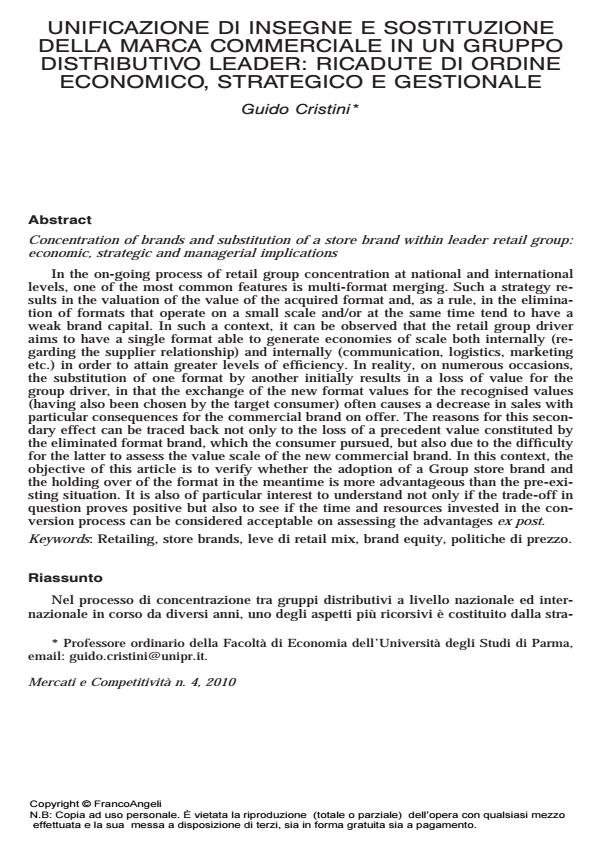Concentration of brands and substitution of a store brand within leader retail group: economic, strategic and managerial implications
Journal title MERCATI E COMPETITIVITÀ
Author/s Guido Cristini
Publishing Year 2010 Issue 2010/4 Language Italian
Pages 24 P. 121-144 File size 553 KB
DOI 10.3280/MC2010-004008
DOI is like a bar code for intellectual property: to have more infomation
click here
Below, you can see the article first page
If you want to buy this article in PDF format, you can do it, following the instructions to buy download credits

FrancoAngeli is member of Publishers International Linking Association, Inc (PILA), a not-for-profit association which run the CrossRef service enabling links to and from online scholarly content.
In the on-going process of retail group concentration at national and international levels, one of the most common features is multi-format merging. Such a strategy results in the valuation of the value of the acquired format and, as a rule, in the elimination of formats that operate on a small scale and/or at the same time tend to have a weak brand capital. In such a context, it can be observed that the retail group driver aims to have a single format able to generate economies of scale both internally (regarding the supplier relationship) and internally (communication, logistics, marketing etc.) in order to attain greater levels of efficiency. In reality, on numerous occasions, the substitution of one format by another initially results in a loss of value for the group driver, in that the exchange of the new format values for the recognised values (having also been chosen by the target consumer) often causes a decrease in sales with particular consequences for the commercial brand on offer. The reasons for this secondary effect can be traced back not only to the loss of a precedent value constituted by the eliminated format brand, which the consumer pursued, but also due to the difficulty for the latter to assess the value scale of the new commercial brand. In this context, the objective of this article is to verify whether the adoption of a Group store brand and the holding over of the format in the meantime is more advantageous than the pre-existing situation. It is also of particular interest to understand not only if the trade-off in question proves positive but also to see if the time and resources invested in the conversion process can be considered acceptable on assessing the advantages ex post.
Keywords: Retailing, store brands, leve di retail mix, brand equity, politiche di prezzo
- Growth factors of store brands in different store formats in Italy Guido Cristini, Fabrizio Laurini, in The International Review of Retail, Distribution and Consumer Research /2017 pp.109
DOI: 10.1080/09593969.2016.1267658
Guido Cristini, Unificazione di insegne e sostituzione della marca commerciale in un gruppo distributivo leader: ricadute di ordine economico, strategico e gestionale in "MERCATI E COMPETITIVITÀ" 4/2010, pp 121-144, DOI: 10.3280/MC2010-004008